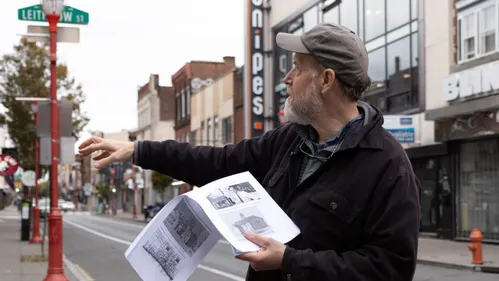Stay in the Loop
BSR publishes on a weekly schedule, with an email newsletter every Wednesday and Thursday morning. There’s no paywall, and subscribing is always free.
Exploring the rich past, present, and future of Philly theater
Adventures in Theater History: Philadelphia, by Peter Schmitz

On a chilly morning in late November, I met Peter Schmitz at the corner of Front and South Streets, and over the course of an hour, he guided me into the history of Philadelphia theater. Amid colonial streets now dotted with coffee shops and fast-food restaurants, Schmitz expounded on the performance customs of the pre-Revolution era, the rich traditions of Black and Jewish companies that once filled these areas, and the birthplaces of local luminaries like Edwin Forrest and Molly Picon.
I first came to know Schmitz—a loquacious and affable Midwesterner who’s called Philly home since 2005—as an actor, dialect coach, and professor. For the past six years, though, the events that filled our morning walk have become an ever-widening part of his life. Schmitz’s interest in history prompted him to launch a podcast and social media channel, Adventures in Theater History: Philadelphia, which chronicles the rich past, present, and future of the art form in the city. He has also led themed walking tours like the one with which he indulged me.
A Yale history major turns to theater
Schmitz’s work now culminates with the publication of a new book, also called Adventures in Theater History: Philadelphia, from the local imprint Brookline Books. The project, which Schmitz began conceiving during the pandemic, allows him to combine his love of history and his life’s work as a theater artist and educator.
“I majored in history at Yale, and I’ve always loved it,” he told me over tea when our walking tour concluded. “I was actually accepted into the PhD program in theater at Stanford, but I decided that I wanted to have a career as an actor instead. I don’t think I’ll go back for a PhD at this stage in my life, but this scratches the same itch!”
Schmitz brings a scholar’s rigor to both his writing and his research, but he also manages to make his subject engaging and appealing to a lay audience. On the page, his voice is passionate yet endearing, his deep appreciation for the project always evident. And as we walked down blind alleys and side streets in Society Hill and Queen Village, he dispensed information with a performer’s rapid-fire delivery, while still maintaining a narrative thread.
Touring Philly theater history
At South and Hancock, Schmitz pointed out a nondescript nail salon. He informed me that a playhouse called the Theatre at Society Hill once existed on that site. “There are no known renderings of it, so no one really knows what it looked like,” Schmitz said. “It’s entirely lost to time.” Or it would be—were it not for the intrepid historians like Schmitz who keep it alive in their memories. (He also pointed out that the theater is not to be confused with the nearby Society Hill Playhouse, which operated from 1959 to 2016.)

Many of the early theaters here, Schmitz said, operated in this part of Philadelphia because, in the pre-Revolution days, it was not technically considered a part of the city. The first theater in the neighborhood, Southwark Playhouse, was founded in 1766. The first US performance of Hamlet happened on these blocks, and giants of the Yiddish theater like Boris Thomashefsky regularly performed in the neighborhood. The area remained a hub of theater throughout much of the 20th century: Theatre of the Living Arts, now a concert venue, was a pioneering avant-garde playhouse in the 1960s when it was run by legendary auteur André Gregory.
A historic morning practice
Schmitz brings his playful archivism to social media, too, posting daily micro-essays on the history of Philadelphia theater. Since so few Philadelphia theaters have public-facing archives—especially those no longer in existence—Schmitz begins every day with a post about a notable Philadelphia event from the past. Recent stories at the time of this writing have included Paul Robeson appearing in the musical John Henry at the Erlanger Theatre in 1939, the Philadelphia debut of actor Thomas Abthorpe Cooper at the New Theatre in 1796, and the return of the Metropolitan Opera in December 1948 to the Academy of Music, with a performance of Wagner’s Götterdämmerung.
“I consider it part of my morning practice now,” Schmitz said. “I wake up very early and I take a look at Newspapers.com, the newspaper archive, and I try to find something interesting that happened on that day. It’s a great way to keep history alive and in the social media conversation.”
Schmitz continues to perform—he was seen most recently in Boca at Act II Playhouse last summer—and he teaches a variety of courses at Temple University. But he seems pleased to be known increasingly as Philly’s theater history guy. And he recognizes that there’s always more to discover. “Philadelphia theater is deep enough and narrow enough to travel the whole river,” he said.
Peter Schmitz will be reading from and signing copies of Adventures in Theater History: Philadelphia on Wednesday, December 18, at 7pm at Narberth Bookshop.
What, When, Where
Adventures in Theater History: Philadelphia. By Peter Schmitz. Havertown: Brookline Books, November 2024. 328 pages, available in hardcover and digital download; $9.95-$34.95. Get it here.
Sign up for our newsletter
All of the week's new articles, all in one place. Sign up for the free weekly BSR newsletters, and don't miss a conversation.

 Cameron Kelsall
Cameron Kelsall